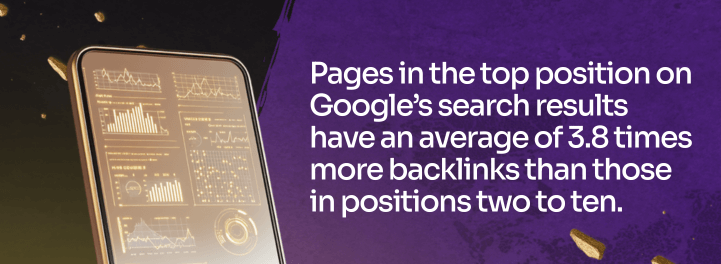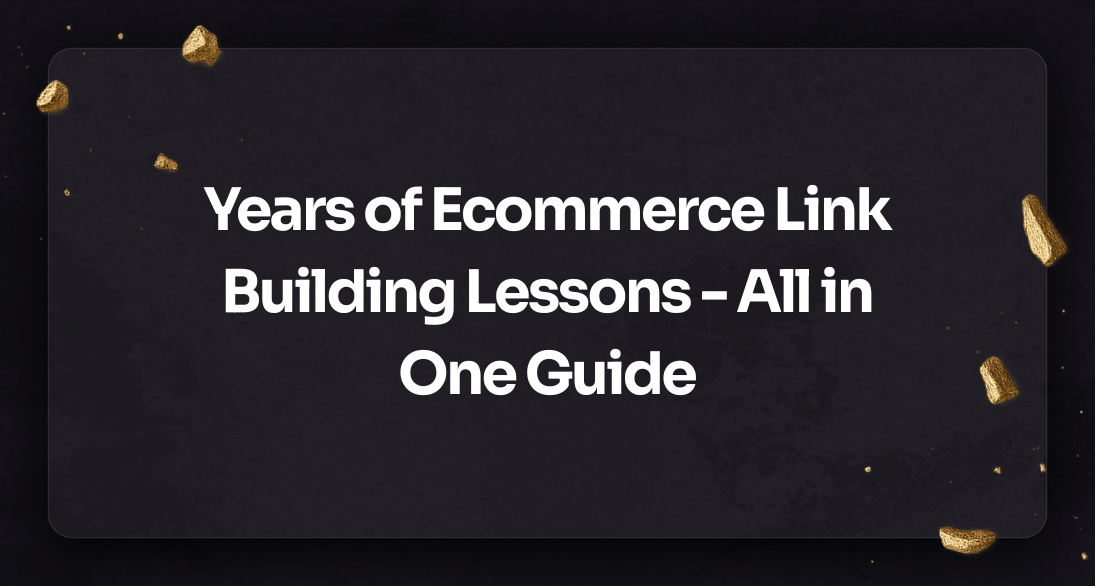Link building can catapult your ecommerce store higher in search results, yet it’s only one piece of a winning SEO strategy.
It’s simple: the higher you rank on Google, the more customers discover your ecommerce store before anyone else.
Only 21.4% of link builders now rely mainly on manual outreach, down from 38.2% last year.
Why the change?
Smart ecommerce brands figured out that backlinks are votes of confidence that tell Google your site deserves to be seen. For online stores specifically, the quality and relevance of these backlinks matter way more than sheer quantity.
We've tested dozens of link building strategies for ecommerce sites over the years. Some crashed and burned. Others delivered results that made a measurable impact on traffic and sales.
This guide shares the link building strategies we’ve refined through years of work - the ones that secure strong ecommerce backlinks while keeping budgets in check and processes efficient.
These methods come from our own campaigns and client successes, helping ecommerce brands rise above their competition in search results.
It’s time to build links that put your store in front of customers who are ready to buy.
Understanding Ecommerce Backlinks
Backlinks aren't just random connections between websites. They tell search engines who deserves a top spot.
Let’s explore why they’re so important for getting your ecommerce store noticed.
What Are Ecommerce Backlinks?
Ecommerce backlinks are links from external websites that point directly to your online store. Think of them as digital votes of confidence - other sites vouching for your credibility.

Unlike internal links that connect pages within your site, these inbound links come from entirely different domains.
Each backlink works as a recommendation. It tells search engines like Google that another website considers your content valuable enough to reference.
These links collectively form your "backlink profile" - essentially a digital reputation portfolio for your ecommerce site.
Their value depends on three crucial factors:
- Authority - The overall strength and trustworthiness of the linking domain
- Power - The specific strength of the individual page containing your link
- Relevance - How closely the linking site relates to your industry or niche
A backlink from an established fashion blog to your clothing store carries far more SEO weight than one from an unrelated tech forum because it’s relevant and authoritative.
Search engines evaluate both standard links that pass ranking signals and nofollow links, which might not directly influence rankings but can still bring valuable referral traffic.
How Backlinks Impact SEO for Ecommerce Sites
The influence of backlinks on ecommerce SEO? Massive.
Search engines interpret quality backlinks as evidence that your store deserves higher placement in results.
Higher rankings translate directly to increased visibility and traffic. Ecommerce backlinks don't just improve your general search presence; they can impact your product pages in Google Shopping listings too. Research shows that even just one or two quality backlinks can significantly boost Shopping listings.
Backlinks also drive qualified referral traffic: visitors who arrive at your store through links on other websites. These visitors often show higher commercial intent than random searchers, making them particularly valuable potential customers.
Most importantly? Ecommerce backlinks build domain authority over time.
This creates a virtuous cycle where increased authority leads to better rankings, which attracts more backlinks, further strengthening your position. This way, your ecommerce site gradually outranks competitors, capturing more organic traffic and conversions.
Why Ecommerce Sites Struggle with Link Building
Despite their importance, acquiring quality backlinks presents unique challenges for ecommerce websites.
The primary obstacle? Product and category pages (which make up the bulk of ecommerce sites) aren't naturally linkable. While blogs and news sites regularly attract links through informative content, standard product listings rarely inspire other websites to link naturally.
Online stores face additional hurdles:
Competition in ecommerce is exceptionally fierce due to low barriers to entry. New stores must compete against established giants like Amazon and eBay for visibility, creating an uphill battle for backlinks. Even well-funded operations struggle to match the link profiles of major retailers.
Product lifecycles present another significant challenge. With merchandise constantly changing, links pointing to specific product pages risk becoming irrelevant or broken when items are discontinued. This creates instability in the backlink profile that requires constant maintenance.
Many website owners and bloggers hesitate to link to ecommerce sites without firsthand experience using the products. They view such links as implicit endorsements, raising concerns about potential conflicts of interest or appearing biased to their audiences.
Perhaps most fundamentally, ecommerce prioritizes immediate sales results while effective link building requires long-term investment. This creates tension between short-term revenue goals and the sustained effort needed to build a robust backlink profile that delivers lasting SEO benefits.
Understanding these challenges is the first step toward overcoming them with strategic techniques tailored specifically to ecommerce websites.
Which is exactly what we'll explore next.
What Makes These Techniques Different
Quality continues to outweigh quantity in ecommerce link building - a principle affirmed by 92% of marketing professionals who expect this trend to persist over the next five years.
I’ve experimented with countless strategies for different online stores and discovered that the best ones share certain traits that separate them from methods that simply don’t deliver.
What Makes a Link Building Technique 'Game-Changing'?
The most effective link building tactics for ecommerce brands share three essential traits:
Sustainable impact - Short-term tactics might give you a brief rankings bump, but superior techniques build authority that grows over time.
Relevance to your niche - Links from websites closely related to your store send stronger signals to Google than random mentions from unrelated sites.
Natural integration - The most valuable links sit inside useful content - not stuck in sidebars or shoehorned into random text.
While basic guest posting might secure a few links, comprehensive strategies like digital PR campaigns can generate hundreds of high-quality backlinks from a single well-executed effort.
The difference? Scale and sustainability.
How We Selected These Techniques
Our selection process focused on real-world effectiveness across different ecommerce niches. Before recommending any technique, we evaluated it against strict criteria.
First, we conducted thorough competitor backlink analysis using tools like Ahrefs and Semrush to identify what's working within specific industries. This competitive intelligence revealed opportunities our clients could capitalize on.
Second, we tracked specific metrics beyond just link quantity, including domain authority (specifically targeting sites with DA 50+), link placement within content, and most importantly - actual impact on search rankings and traffic.
Third, we monitored long-term sustainability. Many techniques deliver impressive initial results before quickly fading.
We found three content types consistently outperform all others for generating quality backlinks: ultimate guides, original research, and interactive tools. These assets provide genuine value that naturally attracts links rather than requiring constant outreach.
Balancing Manual and Organic Link Building
The most successful ecommerce link building strategies combine both manual efforts and organic approaches.
Manual link building involves intentional outreach to secure placements on quality sites - a time-intensive but highly effective solution.
Manual techniques deliver strategic control over where your links appear and the context surrounding them. They generate links that do more than just pass SEO value - they signal credibility and bring qualified referral traffic.
Organic link building focuses on creating exceptional content that naturally attracts backlinks. It requires significant upfront investment but delivers compounding returns as content continues attracting links over time.
By doing something truly notable and reaching out to journalists, well-conceived digital PR campaigns can build hundreds of high-quality links mixing both dofollow and nofollow attributes.
For ecommerce specifically, resource pages have proven exceptionally valuable since they exist primarily to link out to helpful content. Creating linkable assets like comprehensive guides or original research provides a foundation for building an authoritative backlink profile that raises your entire site's visibility.

Ten Strategies That Build Quality Ecommerce Links
Building backlinks for ecommerce stores requires targeted techniques that deliver both SEO value and qualified traffic. After examining hundreds of ecommerce sites, I've identified ten strategies that consistently outperform others.
1. Content Marketing for Ecommerce Links
Creating valuable blog content remains one of the most effective link building tactics for ecommerce brands. High-quality content pieces naturally attract backlinks over time, freeing you from constant outreach. The key is developing posts that target keywords relevant to your products while addressing customer pain points.
If you sell surfboards, a guide on "best surfboards for beginners" could attract links from surf schools or related blogs. These content-driven backlinks build authority gradually - often taking 3-12 months to significantly impact site visibility.
The formats that work best:
- Ultimate guides that cover industry topics comprehensively
- Case studies showcasing real customer success stories
- Original research providing valuable industry insights
2. Guest Blogging Opportunities
Guest posting remains beneficial for ecommerce sites seeking targeted backlinks. It helps you tap into pre-existing audiences on authoritative websites, boosting your brand's credibility and authority. Research blogs that align with your niche, then reach out to determine if they accept guest posts.
Keep your pitch concise. Introduce yourself with writing samples and suggest specific topic ideas. Most sites allow one backlink per guest post, making each opportunity valuable.
3. Collaborating with Influencers
Connect with relevant influencers to access high-authority websites and strengthen your social promotion.
The key advantage? Influencer-generated content creates a beneficial relationship between brand awareness and SEO improvement. For maximum impact, select influencers whose audiences align with your target demographic.
Micro-influencers with smaller yet highly engaged followings often generate higher quality backlinks compared to those with larger, less engaged audiences. Start building relationships by engaging with potential partners' content before making direct outreach requests.
4. Using HARO for Link Opportunities
HARO (Help a Reporter Out) has become one of the most loved ecommerce link building strategies among SEO professionals. This platform connects journalists with sources who can provide expert insights on industry topics.
Through HARO, ecommerce sites can secure backlinks from prestigious publications like The New York Times and Wall Street Journal, avoiding the high costs of traditional PR agencies.
HARO queries are categorized by topic, enabling you to respond only to relevant opportunities.
For successful HARO outreach, respond quickly to queries, craft clear subject lines, and get to the point immediately in your pitch. While highly competitive, this solution delivers high-authority backlinks that significantly enhance your site's SEO performance.
5. Creating Shareable Infographics
Infographics combine visually engaging content with valuable information, making them highly shareable for link building. When other websites embed your infographic, they typically link back to your site as the source.
Focus on creating infographics around topics that resonate with your audience while presenting useful data or insights.
To maximize link acquisition, submit your infographic to directories like Visual.ly and Daily Infographic, reach out to relevant bloggers, and provide an embed code that makes it easy for others to share your creation while linking back.
6. Digital PR Campaigns
As we’ve already mentioned, well-executed digital PR campaigns can result in hundreds of new referring domains from a single viral effort.
The most beneficial ways include conducting original surveys, analyzing existing data creatively, and developing unique campaigns that capture media attention.
Digital PR campaigns generate not just backlinks but also brand mentions and media coverage - essential signals that Google uses to determine your site's reputation and E-E-A-T.
That's called laying the foundation. The biggest gains come when you go deeper.
Advanced Ecommerce Link Building Techniques
Basic tactics get you started. Advanced ecommerce link building strategies get you ahead.
After establishing foundational link building tactics, data-driven approaches give ecommerce sites the competitive edge needed to outrank larger competitors. These advanced techniques require more effort but deliver substantially higher returns on investment.
7. Competitor Backlink Analysis
Competitive intelligence forms the backbone of strategic link building. Instead of starting from scratch, I analyze where competitors earn their links to uncover ready-made opportunities. This helps identify websites already interested in our niche.
Tools like Ahrefs and Semrush reveal crucial insights through their Link Intersect features. I specifically target domains linking to multiple competitors rather than just one - these sites are more likely to link to you since they're demonstrably interested in your industry and probably don't have exclusive deals with your competition.
For maximum effectiveness:
- Examine competitors' highest-performing content to identify which pages attract the most links
- Look for patterns in the types of sites linking to competitors (resource pages, industry blogs, etc.)
- Filter for "Best" prospects in Semrush's Backlink Gap tool, which shows domains linking to all competitors but not to you
The goal isn't copying competitors' strategies. It's identifying gaps - sites linking to competitors that should logically link to you too.
8. Broken Link Building
Broken link building creates a win-win situation. Site owners don't want dead links frustrating their visitors, while you need quality backlinks. Simple math.
First, use tools like Check My Links or SEO Minion to identify broken links on industry-relevant sites. Once identified, check if you have existing content that could naturally replace the dead link; considering both the anchor text and surrounding context.
Most site owners happily update broken links when presented with a suitable replacement, as they don't want to direct readers to 404 pages.
The beauty of this technique? You're helping first, asking second.
9. Link Reclamation
Link reclamation prevents you from losing as many links as you build. Approximately 18% of backlinks result in a 404 error or redirect to irrelevant pages, making this technique particularly valuable.
The process involves two main approaches:
First, fix broken internal links within your site using tools like Google Analytics. This preserves existing link equity and improves user experience.
Second, reclaim external broken links pointing to your site. Common causes include website updates, deleted pages, broken redirect chains, and content reorganization.
Tools like Ahrefs' "Broken backlinks" report identify these opportunities by showing all links currently broken with their referring pages and anchor text.
10. Building Resource Pages
Resource pages (collections of valuable industry links) represent untapped opportunities for ecommerce link building. These pages exist primarily to link out to helpful content, making them perfect targets.
Creating your own resource pages with FAQs and comprehensive information positions your store as an industry authority. Meanwhile, getting featured on existing resource pages requires identifying relevant opportunities and demonstrating genuine value.
To find resource page opportunities, use search strings like "[your niche] + resources" or "inurl:[your niche] + resources". Before pitching, ensure your content genuinely belongs on that page - look for relevance to your niche and alignment with existing resources.

Link Building for Small Ecommerce Sites
Small ecommerce businesses demand targeted techniques. Unlike large retailers, smaller online stores need solutions that maximize impact without maxing out the budget.
You can't outspend Amazon. But you can outmaneuver them locally.
Targeting Local Publications
Local media outlets are goldmines of link building for small ecommerce sites. Press releases about store milestones or product launches can generate coverage with valuable links.
Better yet? Sponsoring contests in local newspapers practically guarantees backlinks, as publications promote sponsors on their websites and social media.
Become a vocal commentator on local issues. This builds relationships with journalists who might seek your expert opinions for future stories. Many local publications now have robust online presences, making them excellent backlink sources with high domain authority.
The local press wants local angles. Give them what they need.
Community Engagement and Sponsorships
Sponsoring local events creates direct backlink opportunities from event websites while building brand recognition. Event organizers typically acknowledge sponsors with links on their sites.
Partnerships with complementary local businesses foster mutual growth through link exchanges and co-branded marketing initiatives.
Community workshops or webinars position your brand as an authority while encouraging participants and partners to link back to your site. These community connections build natural backlink networks that signal trustworthiness to search engines.
Show up consistently. Be helpful first, promotional second.
Using Niche Directories
Niche directories significantly improve local SEO by categorizing websites based on specific industries. When creating listings, optimize for local keywords relevant to your business location to improve visibility in local searches.
Maintaining consistent Name, Address, and Phone (NAP) information across all directory listings proves crucial for search engines determining business legitimacy.
Actively encouraging customer reviews on these platforms enhances both visibility and credibility, substantially impacting local search rankings.
Forums and Q&A Platforms
Forums and Q&A sites like Reddit (with over 1.1 billion monthly visits) and Quora (437 million monthly visitors) hold strong potential for ecommerce link building.
Add genuine value before including any links. First, identify spaces where your target audience gathers, then establish yourself as a helpful community member.
Link naturally only when truly relevant to discussions, avoiding the appearance of self-promotion.
Remember: these communities spot fake helpfulness from miles away.
.
Monitoring and Maintaining Your Backlink Profile
Building links is half the battle. Keeping them is the other half.
Successful ecommerce link building doesn't stop once you've secured those backlinks. Regular monitoring separates thriving online stores from those that get blindsided by algorithm updates.
Tracking New and Lost Links
Backlinks come and go. That's the nature of the web.
Semrush's Backlink Audit Tool tracks domains in your profile that have been newly acquired, lost, or broken through its "Lost and Found" report. This tool shows how each category performs daily over a 90-day period.
Monitor newly acquired domains first. Evaluate which links have the greatest potential to improve your rankings and traffic. Then check for recently lost links - you may still be able to recover them by contacting the referring sites.
Evaluating Link Quality Over Time
Not all backlinks age like fine wine. Some turn into digital vinegar.
Quality assessment requires examining:
- Authority of linking domains
- Anchor text distribution (avoiding over-optimization)
- Link placement within content
- Audience engagement through the linking site
These factors help determine whether backlinks continue providing value or become irrelevant dead weight. Throughout this process, remember that pursuing real, worthwhile links remains paramount to search success.
Avoiding Toxic Backlinks
These harmful links typically come from spammy, irrelevant, or low-quality sources.
Google's Gary Illyes suggested that disavows often do more harm than good. But if you've received a manual action for unnatural links? Action becomes necessary.
To identify potentially harmful links, check Google Search Console or use specialized tools that assign toxicity scores. Look for warning signs like excessive money anchor text or compound anchor text containing your brand name plus another phrase.
Using Tools Like Ahrefs and Semrush
Both platforms offer solid backlink monitoring capabilities with distinct advantages.
Ahrefs excels with its massive backlink database and exceptional analysis capabilities. Their "broken backlinks" report identifies opportunities to recover lost link equity.
Semrush provides approximately 16 different reports under Backlink Analytics, giving a complete picture of your backlink profile from various angles.
Wrap Up
Link building remains one of the most decisive levers for ecommerce growth - but only when approached with precision, creativity, and persistence.
From crafting content that earns organic links to reclaiming lost opportunities and leveraging advanced tactics like competitor analysis and digital PR, successful ecommerce brands know that sustainable SEO results don’t come from shortcuts. They come from well-executed efforts that align with how real people search, engage, and buy.
As user behaviors shift and search engines grow more sophisticated, what worked yesterday may not hold the same weight tomorrow. That’s why the real advantage lies in staying proactive: continuously testing new techniques, monitoring your backlink health, and always prioritizing quality over quantity.
Because in the end, it’s not about chasing every link - it’s about building the right ones. The links that connect your ecommerce store to customers who are ready to buy, elevate your authority, and set you apart in a crowded market.
So whether you’re running a niche online boutique or scaling a national brand, invest the time and effort into smart link building. It’s one of the few SEO investments that keeps paying dividends long after the work is done.
Frequently Asked Questions
Q: What is link building in ecommerce?
Link building in ecommerce is the process of acquiring hyperlinks from other websites to your online store. These links act as endorsements, signaling to search engines that your site is credible and relevant. The result? Higher rankings, increased visibility, and more traffic from people actively searching for your products.
Q: What are some effective link building tactics for ecommerce brands?
Some ecommerce link building tactics include content marketing, guest blogging, collaborating with influencers, using HARO for media opportunities, creating shareable infographics, and running digital PR campaigns. These techniques help build high-quality, relevant backlinks that can improve search rankings and drive targeted traffic.
Q: How can small ecommerce businesses build quality backlinks?
Small ecommerce businesses can focus on targeting local publications, engaging in community sponsorships, leveraging niche directories, and participating in relevant forums and Q&A platforms.
Q: Do backlinks to product pages matter?
Yes, but they’re harder to earn. Product pages often aren’t “naturally linkable” because they’re sales-focused. However, backlinks to these pages can improve their rankings in both organic search and Google Shopping results, directly impacting sales. Building content around products or categories can help funnel link equity to these pages.
Q: Are nofollow links useful for ecommerce SEO?
Absolutely. While nofollow links don’t reliably pass ranking power, they still drive referral traffic, boost brand awareness, and can lead to future link opportunities. For ecommerce stores, a mix of dofollow and nofollow links creates a more natural backlink profile.
Q: Why is backlink quality more important than quantity for ecommerce sites?
Quality backlinks from authoritative and relevant sources have a much stronger impact on search rankings than a large number of low-quality links. Even a single high-quality backlink can significantly boost an ecommerce site's visibility, especially in Google Shopping listings, making it more effective to focus on acquiring fewer but more powerful links.
Q: How can ecommerce sites monitor and maintain their backlink profile?
Ecommerce sites should regularly track new and lost links, evaluate link quality over time, avoid toxic backlinks, and use tools like Ahrefs and Semrush for comprehensive backlink analysis. This ongoing monitoring helps identify opportunities to recover lost links and ensures the backlink profile remains healthy and beneficial for SEO.
Q: What makes an ecommerce link building technique 'game-changing'?
A game-changing link building technique for ecommerce typically delivers sustainable impact, is highly relevant to the store's niche, and integrates naturally within content. These techniques, such as digital PR campaigns or creating linkable assets, can generate numerous high-quality backlinks, significantly improving the site's authority and search visibility.






